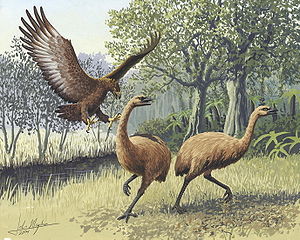Paleoecology of Magnificent Megafauna: The Moa
There was a time not so long ago (thousands of years ago, not millions, which is not so long ago to a paleontologist) when ecosystems around the world had something that is generally lacking today: really big herbivores. I’m talking beasts such as giant armadillos, giant sloths, mastodons, and mammoths. Obviously there aren’t any mastodons lumbering around your neighborhood today, so what happened to them? In general, there are two main hypotheses: either humans ended their reign or climate change eliminated their preferred habitats. These hypotheses are hotly debated in the literature, but as it is difficult to prove any absolute cause in certain cases, the debate still rages on.
No matter what caused their extinction, extinct herbivore megafauna can still be extremely useful in studying climate change. What evidence is there about the structure of habitats where megafauna lived? Just this week a paper in PNAS seeks to answer this questions in great detail. And how did they do it? Ancient bird poop, of course.
The New Zealand moa was a giant herbivorous bird that has been extinct since 1400 AD. The two largest species of moa would have been around 12 feet tall and weighed up to 500lbs! Their extinction, like other megafauna, has been debated to be caused by overhunting and/or habitat loss. Due to the fact the moa only lived with one other animal that was big enough to eat it- Haast’s eagle– it is likely humans caused their extinction. The moa is a relatively well studied animal for being extinct: we have even been able to sequence their genome and see what kinds of parasites lived in their guts. The nine extinct species of moa were endemic to New Zealand and they likely shaped the plant communities they lived in, but it is difficult to know for sure when we were unable to critically assess their impact. The study of ancient poop (coprolites, which I also talked about here) can remedy these issues.

In this study, the authors analyzed 51 coprolites rigorously: they were carbon dated, and individually assessed for ancient DNA (aDNA), plant macrofossils, and fossil pollen. Ancient DNA is critical in this type of study because not only does the DNA tell us that these coprolites are from four different moa species, but they can also provide DNA identification of the plant remains contained in the coprolite. Additional pollen and macrofossil study provide a detailed list of what plants were present at this site 400 years before the extinction of the moa. This combination of methods is extremely rigorous, and an incredible way of measuring paleoecology quantitatively. The results indicate that there were four species of moa living at the same time in the same area but occupying different dietary niches.

It stands to reason that ecosystems can be vastly changed when key organisms are removed. Large birds like moa likely had an impact on habitats through altering vegetation composition and seed dispersal. The species of moa from this study had dietary preferences from forest plants to grasses, and everything in between. In response to the idea that other herbivores could be introduced into ecosystems to mimic the effect a moa might have had on the vegetation community, the authors note modern ostriches and emus do not occupy the same dietary niche spaces as the extinct moa, and would be a poor replacement herbivore in a New Zealand ecosystem.
I think this study is so great because it really drives home the power of a multiproxy approach for understanding paleoecology. Combining traditional methods of fossil analysis with “newer” methods of aDNA and carbon creates a very clear picture of an ancient environment that otherwise would be impossible to obtain.
Reference:
Resolving lost herbivore community structure using coprolites of four sympatric moa species (Aves: Dinornithiformes). Jamie R. Wood, Janet M. Wilmshurst, Sarah J. Richardson, Nicolas J. Rawlence, Steven J. Wagstaff, Trevor H. Worthy, and Alan Cooper. PNAS 2013 ; published ahead of print September 30, 2013, doi:10.1073/pnas.1307700110
